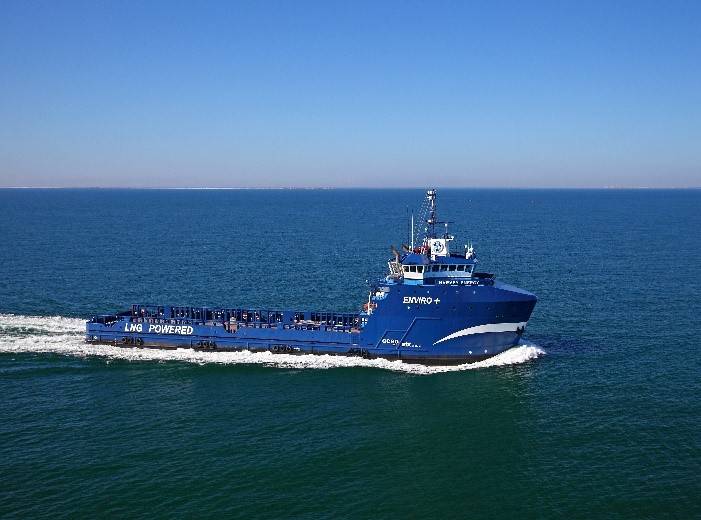Interview: Shane Guidry, Harvey Gulf
Shane Guidry transformed Harvey Gulf from an inland and offshore towing vessel operator to a provider of offshore vessel services in the Gulf of Mexico and international oil and gas markets. Innovation initiatives he has spearheaded include, among others, leading the company to become the United States’ first owner and operator of liquefied natural gas (LNG)-powered offshore support vessels, as well positioning the firm as the first LNG bunkering facility operator in the U.S. The chief executive is intimately involved in the day-to-day operations of the company, with a hands-on approach to business development, merger and acquisition activity, client management, vessel design and sales and marketing. Here, he comments on the state of the business, green technologies and “walking the walk”.
Harvey Gulf is well known for its strides in alternative fuels, batteries and vessel emissions reduction. Please describe the business case for “going green” and why doing so is important and beneficial to Harvey Gulf.
SG: Back in 2011, we saw this as the future of our business as we planned ahead for drastic emissions standard changes due to occur in 2016 and 2020. We wanted to build for the future. We also must consider the requirements of our customers and lenders.
The company has made big pushes into liquefied natural gas (LNG), but how do you see the future for other clean-burning fuels? Do you think they could have a bigger place in the offshore vessel market?
SG: Today, LNG, renewable LNG (RLNG) and battery power is the answer to lowering our carbon footprint. Tomorrow, maybe the question isn’t why or why not, but when will the customer be willing to pay more for vessels with all this carbon reduction assets, as today they still don’t. And when will the government offer tax credits for companies using these carbon reduction technologies? Until then, companies just won’t commit the capital.
You’ve also pointed out at various times that many of your competitors aren’t willing to spend the capital for emissions-reducing technologies. So, with customers still not paying extra for these vessels, how has Harvey Gulf been able to commit LNG, batteries, etc. when others haven’t?
SG: I don’t run my company monkey-see, monkey-do. I also put my money where my mouth is, unlike many oil and service companies who talk the talk but won’t walk the walk like I do.
 (Photo: Harvey Gulf)
(Photo: Harvey Gulf)
Please describe the size and shape of the Harvey Gulf fleet. What portion is currently active, and where is Harvey Gulf looking for opportunities?
SG: We are currently operating 42 vessels with 15 still to reactivate. I actually don’t see many new opportunities as things are just too expensive to build. I do see growth in wind someday, but it’s far out into the future. Yes, there will be some assets built for the wind market but the lion share will be later.
U.S. offshore wind is now—finally—ramping up in a meaningful way, though. So, is Harvey Gulf currently looking to be involved in this industry?
SG: We are looking at it closely, but it all comes down to return on investment. We see where our construction support vessels (CSV) will be needed. Around the world wind farm operators are using oil and gas CSVs for installation and commissioning, cable lay and for long-term service and maintenance. I own four large vessels just like the ones servicing windf arms around the world, and they can be used instead of new purpose-built vessels. We’re also seeing that companies are running to the emerging wind farm market along the U.S. East Coast, accepting contracts cheap. I’d rather let all the bottom feeders go first, then I’ll take contracts at a rate that makes sense to the cost of my vessels.
For U.S. oil and gas, how would you describe the state of the offshore vessel market overall?
SG: It’s off the charts like everything else in America. We are seeing record day rates in every class of vessel. What we aren’t seeing is long-term contracts, which would allow for record spot rates.
 (Photo: Harvey Gulf)
(Photo: Harvey Gulf)
How might the recent conflict in Ukraine and moves by the U.S. and others to curb Russian energy imports affect your business? Do you foresee increased O&G activity in the U.S. Gulf, for example?
SG: I don’t see any reason as to why we wouldn’t see a huge increase in drilling in the U.S.A. and become energy independent. If we drill more, it will allow more profits to be earned so oil companies can then have more profits to invest in wind and other green projects.
How has the COVID-19 pandemic materially impacted your business to date?
SG: Like all companies we were hurt for 12-18 months. Globally, we were affected in Africa, Suriname, Mexico and Trinidad in particular. Cost went up and business opportunities went down, thus hurting our returns. The good news is we are now making record profits just like everyone else is, so it’s all good.
What do you count as your greatest challenge today, and what are you doing to overcome it?
SG: The greatest challenge today is the cost of newbuilds. We can’t grow without being able to afford to build new vessels. I think the only way for us to overcome it is for oil companies to be allowed to drill and produce more so that they can afford to pay more for newbuilds.
 (Photo: Harvey Gulf)
(Photo: Harvey Gulf)













